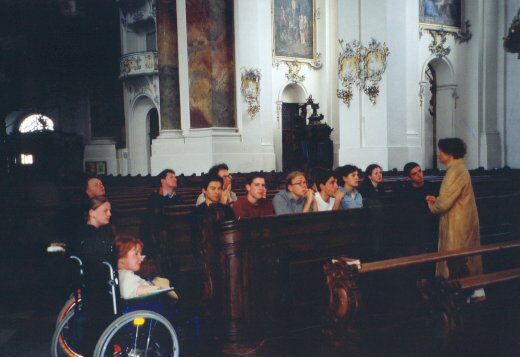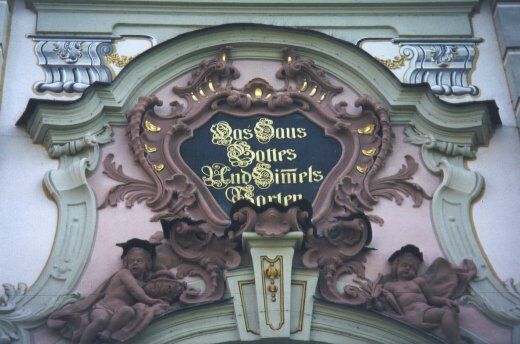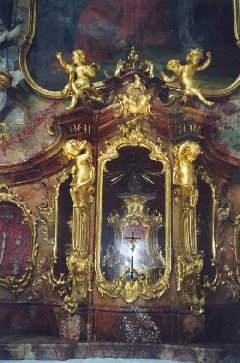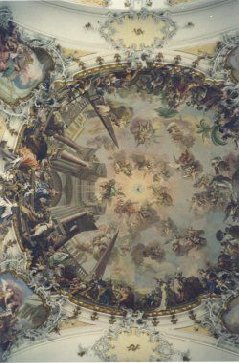Basilica St. Alexander/Ottobeuren
In 764 the first Benedictine abbey was founded in the place where St. Alexander abbey is today. Only between 1802 and 1834 there was no abbey here. In the 12th century existed an important manuscript writing- and painting workshop. In 1509 a printing press was built. In 1558 the fourth church in that place was consecrated, St. Alexander is the fifth. The phrase "Basilica" (abbey) comes from the Greek "Basilikos" and doesn't originally means a church, but a court- and audiencehall for emperors and kings. In 1711 the foundation stone was placed for today's convent. Abbot Ruppert von Ness gave the impetus for the construction to begin in 1737. Unfortunately the finishing of the building he didn't live to see any more. From 1740 Abbot Anselm Erb finished the work, to be exact till 1766.
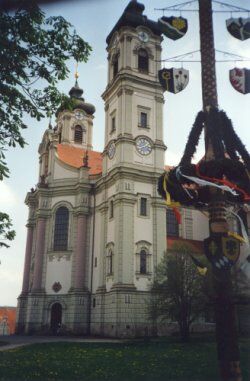
The leading architect was Johann Michael Fischer, the frescoes were by
Johann Jakob and Franz Anton Zeiller; Johann Michael Feichtmayer was responsible
for the stucco. The stalls (Choir) and the "Dreifaltigkeitsorgel"
were designed by Karl Joseph Riepp, the sculptures were created by Johann
Josef Christian. The baroque facade alone is very impressive.
The catholic church suffered very much from the religious quarrels of the 30-year-war. To improve their "image" so to speak they preached not only of miserable existence any more but also about the joy of life and cheerfulness in the kingdom of heaven as well as on earth. So St. Alexander is build in a typical baroque- and rokoko-style: light, colourful with many decorations and cheerful figures. But they also thought of death and therefore there are nevertheless allusions to it in the four openly shown reliquiaries. With the relics whose genuineness was mostly not provable good business had been done in earlier times as well.
The basilica is a good example for the outstanding baroque interior design. When we set foot into the interior of the basilica we first notice the symmetrically arranged columns. They are not made of true marble but of stucco-marble. Towards the middle of the room the columns become more and more bright till they reach the high altar. To draw attention to Jesus, those, that form a frame around him, are again dark as in the beginning. The altarpiece shows among other things the Holy Trinitus - the dove, that is the Holy Ghost on top and scenes from the life of the St. Bendedict. The white figures of St. George, a guardian angel, Josef with the child in his arms etc. as white as the walls.
The puttos, playing on walls and the ceiling, romping cheerfully around.
They aren't completely white. The painting of the Lady- or Rosary altar
shows Pope Pius while praying for victory in a war. Looking eastwards,
you witness the execution of a saint. On this altar there is also a little
statue of the "Saint Mary of Elda". A peasant woman found her
in 1466, prayed to be cured and recovered. Since then the little statue
has been venerated. At Whitsun people bring the statue in a procession
to Elda and back on the very same day if it isn't raining.
In the design of the interior a lot of amusing details can be found, for example a leg made of stucco, which surprisingly sticks out of a painted picture. Something like that can also be seen in the "Wieskirche" and was a kind of fad during the baroque. The roof truss of the basilica is the original one (it has survived both world wars). In the roof truss there are three cupolas, one of them 32 metres high. They are called Monks-, Whitsun- and Angelscupola. The Whitsun cupola shows the Holy Ghost in the shape of a dove. The disciples and apostles were asked to spread their message across all the four continents. Maria Theresia can be seen on the edge, as a representative for Europe. The cross altar shows a cross in Romanesque style, created in 1200. The gloriole was added later. The Saviour has no crown of thorns on his head and is also shown as the One who is risen. His feet are parallel, not crossed.
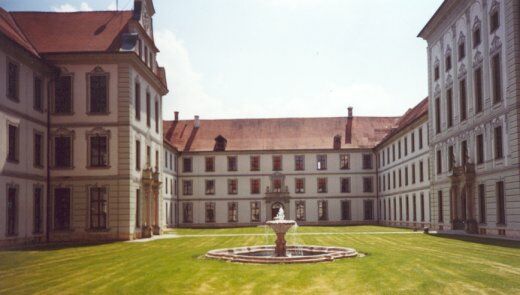
It wasn't until 1926 that the pope made the collegiate church a "Basilica Minor". In 1964 the church was completely cleaned, in some places with dough, to avoid a destruction of the original substances by chemicals. Today the basilica is counted among the biggest baroque convents in Germany and contains a big art collection. All the organ pipes are still working; concerts take place every Saturday. For the 23 monks who live here and their employees the main areas of work are the school, the pastoral work, the guesthouse, the workshops and so on. Apart from the basilica you can also visit the national gallery, the library, the theatre and the "Emperor's ballroom,
